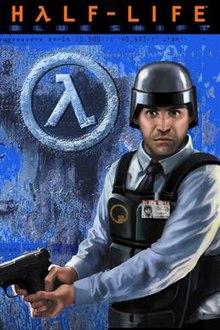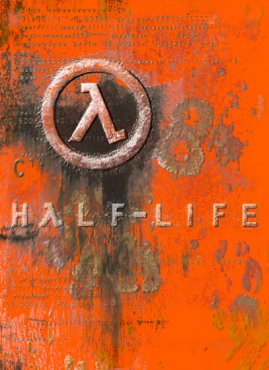
Half-Life is a 1998 first-person shooter game developed by Valve Corporation and published by Sierra Studios for Windows. It was Valve's debut product and the first game in the Half-Life series. The player assumes the role of Gordon Freeman, a scientist who must escape from the Black Mesa Research Facility after it is invaded by aliens following a disastrous scientific experiment. The gameplay consists of combat, exploration and puzzles.
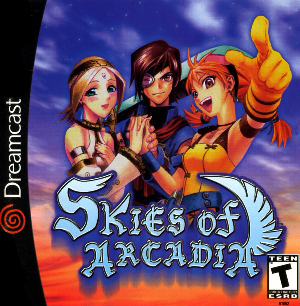
Skies of Arcadia is a 2000 Dreamcast role-playing video game developed by Overworks and published by Sega. Players control Vyse, a young air pirate, and his friends as they attempt to stop the Valuan Empire from reviving ancient weapons with the potential to destroy the world.

Half-Life: Opposing Force is an expansion pack for the first-person shooter game Half-Life. It was developed by Gearbox Software and published by Sierra On-Line for Windows on November 19, 1999. Opposing Force was the first expansion for Half-Life and was announced in April 1999. Lead designer Randy Pitchford noted that he believed Gearbox was selected to develop Opposing Force because Valve, the creators of Half-Life, wanted to concentrate on their future projects. Over the course of development, Gearbox brought in a variety of talent from other areas of the video games industry to help bolster various aspects of design.

The Black Mesa Research Facility is a fictional underground laboratory complex that serves as the primary setting for the video game Half-Life and its expansions, as well as its unofficial remake, Black Mesa. It also features in the wider Half-Life universe, including the Portal series. Located in the New Mexico desert in a decommissioned Cold War missile site, it is the former employer of Half-Life's theoretical physicist protagonist, Gordon Freeman, and a competitor of Aperture Science. While the facility ostensibly conducts military-industrial research, its secret experiments into teleportation have caused it to make contact with the alien world of Xen, and its scientists covertly study its life-forms and materials. In a catastrophic event known as the "Black Mesa Incident", an "anti-mass spectrometer" experiment conducted on Xen matter causes a Resonance Cascade disaster that allows aliens to invade Earth, and is the catalyst for the events of the series.

Half-Life: Decay is a multiplayer-only expansion pack for Valve's first-person shooter Half-Life. Developed by Gearbox Software and published by Sierra On-Line, Decay was released as part of the PlayStation 2 version of Half-Life in 2001. It is the third expansion pack for Half-Life, and like its predecessors, Decay returns to the setting and timeline of the original story, albeit portraying the story from the viewpoint of a different set of protagonists: two scientists working in the Black Mesa Research Facility. Decay is a cooperative multiplayer game, designed to be played by two people working together to pass through the game's levels.
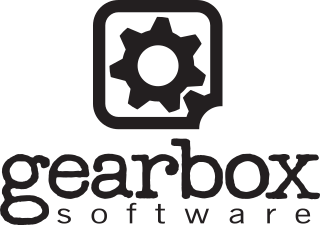
Gearbox Software is an American video game development company based in Frisco, Texas. It was established as a limited liability company in February 1999 by five developers formerly of Rebel Boat Rocker. Randy Pitchford, one of the founders, serves as president and chief executive officer. Gearbox initially created expansions for the Valve game Half-Life, then ported that game and others to console platforms. In 2005, Gearbox launched its first independent set of games, Brothers in Arms, on console and mobile devices. It became their flagship franchise and spun off a comic book series, television documentary, books, and action figures. Their second original game series, Borderlands, commenced in 2009, and by 2015 had sold over 26 million copies. The company also owns the intellectual property of Duke Nukem and Homeworld.

Dark Angel: Vampire Apocalypse is an action role-playing game (ARPG) developed and published by Metro3D for the PlayStation 2 (PS2) home game console.

Sonic Shuffle is a Sonic the Hedgehog-themed party game developed and published by Sega for the Dreamcast in 2000. The game plays like a board game much in the same vein as Nintendo's Mario Party series, with up to four players moving their characters across a game board filled with a variety of spaces which can trigger different events. Some spaces will launch minigames that pit the players against each other in short competitive events.

Starlancer is a space-based science fiction flight simulator computer game, created by Erin and Chris Roberts, and developed by Warthog Games under the auspices of Digital Anvil.

4x4 Evo is a video game developed by Terminal Reality for the Windows, Macintosh, Sega Dreamcast, and PlayStation 2 platforms. It is one of the first console games to have cross-platform online play where Dreamcast, Macintosh, and Windows versions of the game appear online at the same time. The game can use maps created by users to download onto a hard drive as well as a Dreamcast VMU. All versions of the game are similar in quality and gameplay although the online systems feature a mode to customize the players' own truck and use it online. The game is still online-capable on all systems except for PlayStation 2. This was Terminal Reality's only video game to be released for the Dreamcast.

Sega Rally 2 is an arcade racing game developed by Sega for the Model 3 arcade hardware. It is the sequel to 1994's Sega Rally Championship. The game was first released in arcades in February 1998, and was later ported to the Sega Dreamcast, becoming one of the console's earliest titles when it was released in Japan on January 28, 1999. The Sega Dreamcast version was released in Europe as a launch title on October 14, 1999, and then in North America on November 27. A PC version was released in Japan and Europe that same year, with the North American release following suit in September 2000, where it was published by Mattel Interactive.
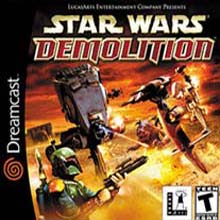
Star Wars: Demolition is a vehicular combat game set in the Star Wars universe created by Luxoflux and LucasArts using the Vigilante 8 game engine. The premise of the game is that the Galactic Empire have banned Jabba the Hutt's podraces, so Jabba creates a more life-threatening vehicular combat contest.

Illbleed is a survival horror game developed by Crazy Games and released for the Dreamcast in 2001. It was published by Crazy Games in Japan and Amusement Interface Associate (AIA) in North America. The game follows Eriko Christy, a high school student who explores a horror-themed amusement park to find her missing friends. The player explores six haunted house attractions based on fictional horror films, detecting and neutralizing hidden traps and enemies which can harm or frighten Eriko and her friends.

Ooga Booga is an online multiplayer video game for the Dreamcast, focusing on the combat of "Kahunas" using thrown shrunken heads, riding animals, staffs, or using spells. The game received positive reviews from video game critics.

Half-Life is a series of first-person shooter (FPS) games created by Valve. The games combine shooting combat, puzzles and storytelling.

NBA Hoopz is a 2001 basketball video game published by Midway. It is the sequel to NBA Hangtime and NBA Showtime: NBA on NBC. Hoopz was the only 3-on-3, arcade-style basketball video game available during the 2000–01 NBA season. Shaquille O'Neal is featured on the game cover.
This is a list of characters in the Half-Life video game series, which comprises Half-Life, Half-Life 2, Half-Life: Alyx, and their respective expansion packs and episodes.

Black Mesa is a 2020 first-person shooter game developed and published by Crowbar Collective. It is a third-party remake of Half-Life (1998) made in the Source game engine. Originally published as a free mod in September 2012, Black Mesa was approved for commercial release by Valve, the developers of Half-Life. The first commercial version was published as an early-access release in May 2015, followed by a full release in March 2020 for Linux and Windows.

Le Mans 24 Hours is a video game released for the PlayStation, Game Boy Color, Dreamcast, PlayStation 2, and Microsoft Windows. The Dreamcast version was ported and published by Sega in Japan on 15 March 2001, while the PlayStation 2 version was ported and published by the same company on 13 June. Based on the famous 24 hours of Le Mans race in France, the player is invited to race the entire 24-hour endurance course or take part in a simpler arcade mode. The game also featured tracks such as Bugatti Circuit, Brno Circuit, Road Atlanta, Suzuka Circuit, Donington Park and Circuit de Catalunya, as well as a weather and night system.
Half-Life is a series of first-person shooter games created and published by Valve. Since the release of the original Half-Life for Windows in 1998, several ports, expansion packs and sequels have been canceled, including projects developed by other studios.
